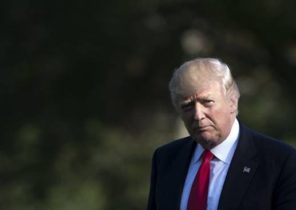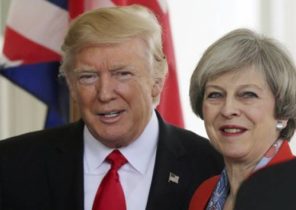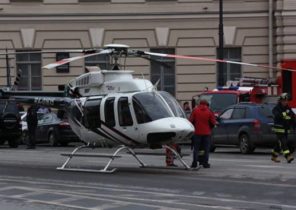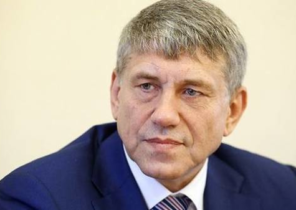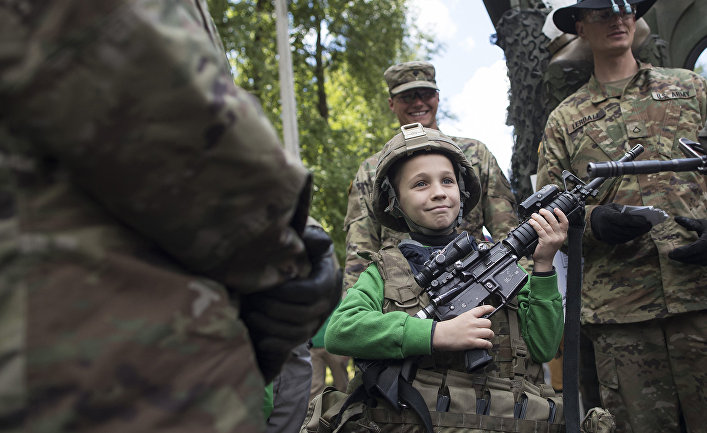
In Lithuania arrived first battalion forward deployed to NATO, whose sole purpose is to reflect, in the case of events under the worst scenario “threat from the East”. The battalion will be staffed mainly by military personnel of the Bundeswehr, Germany. Meanwhile, “in the East” not asleep: in the Kaliningrad region of the Russian Federation carried out military exercises with the use of anti-aircraft missile systems (ADMS) s-400.
After the Ukrainian crisis broke out, the military preparations in the Baltic sea region are on the rise, writes The New Times.
“The validity of Kaliningrad has expired”, — said recently the Deputy of the Lithuanian Seimas Linas, Balsis. According to him, Russia, annexing the Crimea in 2014, destroyed the world order that emerged after 1945, and that means we need to re-discuss the status of the enclave. Official Vilnius from the statements of the MP distanced himself. “Thank God, we’re scared,” he quipped on his page in Facebook Deputy Prime Minister of Russia Dmitry Rogozin, commenting on the statement by Lithuanian foreign Ministry. The Ministry, meanwhile, explained that the status of the Kaliningrad region Lithuania has not contested, in Lithuania, they say, do not have any territorial claims to any of their neighbors. “However, Lithuania and then will not recognize unilateral changes of borders, how does not recognize the occupation and annexation of Crimea by Russia”, — the document says.
The fence as a sign
Meanwhile, the Vilnius perceives a “threat from the East” as a very real and tries to dissociate itself from it in all possible ways. Including literally, with ordinary fence, which in the spring will appear on the border between the Kaliningrad oblast and Lithuania. It will grow by the stretch of 135 km from the point where the borders of Russia, Poland and Lithuania in the area Vishtynetskoye lake, to the place where the border rests on the Niemen, and after that is the river to the Curonian lagoon. Yet the land border represents a conventional control strips and track guards.
According to the Minister of internal Affairs of Lithuania Eimutis of Misunas, soon Vilnius will announce a tender for the construction of the fence through the system of public procurement, and work will begin as soon as the weather gets warmer. Misunas also promised that when there are additional funds, then along the fence mount, and a modern video surveillance system. The construction of the fence from the state Treasury allocated 3.6 million euros. Also, according to Lithuanian press, another 25 million to improve surveillance systems at the borders with Russia and Belarus, the country will receive from the Fund the internal security of the European Union (ISF), which in the period from 2014 to 2020 plans to issue States, strengthening the external border, nearly 1.3 billion euros. These funds will also benefit from its Baltic neighbors — Latvia and Estonia. The first, outlined in the next few years to put a fence on 90 of 270 km of common border with its Eastern neighbor. And the Estonians in 2018 will close from Russia with a fence height of 2.5 meters and a length of 108 km of the Boundary pillars and the test strip will remain only in wetlands. Thus, the project acquires a pan-European scale.
And the head of the interior Ministry, and Prime Minister of Lithuania Saulius Squirrels stated that the fence is primarily for economic purposes — to stop the flow of smugglers. “Lithuania is suffering from the illegal import of cigarettes. Several million euros spent on the fence, definitely will pay for itself”, — said a member of the Committee of the Sejm on national security and defense Arvydas Anushauskas. However, the border guard Service of Lithuania talk about reducing the number of violations and without any fence: if in 2015 such cases it was 215, then in 2016 — a total of 127.
Eimutis Misunas did not hide that to look for new solutions in terms of the protection of the state border Lithuania has pushed not only for economic reasons but is still tense geopolitical situation. And if a fence will not stop a tank, then at least help to prevent incidents like what happened in September 2014: Russian spetsluzhby then abducted Estonian intelligence officer Kohora from the border zone on the territory of Estonia. “The fence is a sign that a neighboring country, we believe it is possible aggressor,” — said Misunas.
NATO — 2%
The construction of the fence on the background of the General militarization of Lithuania really looks like a symbolic gesture. 2014 — since the annexation of Crimea and the outbreak of hostilities in the East of Ukraine — Lithuania had to seriously reconsider its military strategy.
“Then in a society deeply embedded fear that Russia will attack, fear, fueled by painful memories of Soviet occupation,” recalls political analyst, doctor of social Sciences Viktor Denisenko. The threat from Russia’s foreign policy, 60% of Lithuanians, according to a survey commissioned by the Centre for East European studies (Lithuania), seen two years later in April 2016. But in 2014, the companies changed the look of the army: returned understanding that the army must not only participate in NATO operations anywhere in Afghanistan or Iraq, but also to be ready to defend their own territory.
Since then, the article of military spending in the state budget increased from 314 to 725 million euros, is scheduled for 2017. Thus, in the coming year’s military budget will amount to 1.9 percent of GDP. And it’s almost already those cherished 2% that is required on recommendations of NATO. To this bar, at the request of the Minister of defence of Raimundas of Karoblis, the country will reach in 2018, and then — “depending on the level of risk” — the military budget may reach 2.4% of GDP.
The main costs are going to modernize the army, mainly the purchase of new military equipment. In the coming year, according to the Minister of war, funds will be allocated for the purchase of infantry fighting vehicles, self-propelled howitzers, anti-aircraft medium-range and means of antitank defense, upgrade the helicopter fleet.
In addition, almost six million euros spent on the expansion of military infrastructure. New military facilities needed to accommodate allies in Lithuania, as decided at the NATO summit in Warsaw in July last year, came the first battalion of the forces of forward-based NATO led by Germany. By June, the international battalion — about 1,200 people — must be fully deployed.
 © AP Photo Mindaugas KulbisВоеннослужащие of the U.S. army arrived in Lithuania
© AP Photo Mindaugas KulbisВоеннослужащие of the U.S. army arrived in Lithuania
Army is cool
The new Lithuanian government in the face of defense Minister Raimundas of Karoblis promises to raise the salaries of the military not 20 as planned, and as much as 30% — “want — not want, it is necessary to involve specialists, which we currently lack”.
The number of professional servicemen in recent years actually increased slightly, from 7775 in 2013 to the current 8661 people (data from the website of the Ministry of defense of Lithuania. ed.). But with conscripts had to start all over again. In 2008, General conscription was abolished. And only in 2015 in connection with the threat of Russia, President Dalia Grybauskaite has declared the time — for five years — the return of the call. Already the first appeal fully satisfied the needs of the army by the flow of the nearly four thousand people who were without any agenda. “Against the background of General fear and apprehension the young people have shown a willingness to defend their country” — said Viktor Denisenko. The influx was so powerful that even the military was forced to deny a late volunteers. Until 2019 Lithuania hopes to fully restore the system to a General call to increase the number of conscripts to six or seven thousand.
According to Vladas Gaidis, Director of the center for the study of market and public opinion “Vilmorus” in the ranking of public confidence in public institutions, the army confidently took the first place, “She managed to get rid of the backward image of the organization, what it was considered in the 1990s. And only after a recent corruption scandal with so-called “Golden spoons” (see the article in The New Times of November 24, 2016), the army conceded the palm of the police and the Catholic Church.”
Active reserve
In the new conditions added to the ranks and paramilitary organizations of self — defence, “the Lithuanian Riflemen’s Union” and “Volunteer forces for the protection of the region”. The first is rooted in the interwar period, after the Soviet occupation many of its members went to the “forest brothers”. According 2015, the Union included about eight thousand people — most often men aged 40-50 years.
“Volunteer protection force edge”, created in 1991, are part of the land forces of the Lithuanian army. This organization, which now has about 4500 volunteers and five professional military, serves as a base for training active reserve of the army. Service in these forces can be combined with work or studies: teaching occupied on average about thirty days a year. In peacetime the main task — to help the population in case of technogenic and natural disasters, and military — to defend the country along with allied forces. To the volunteers ready to join those who in everyday life is quite far from the army. “I am a former officer of the Soviet army, do you remember how to handle weapons. If Russia attacks, take the gun and go to fight”, — assured the Lithuanian prominent financier Gintautas Galvanauskas. In his top form, no doubt — in his nearly 60 he to late fall commutes to work by bike and regularly takes part in races.
If several years ago the state was neglected and arrows, and reservists, now the Ministry of defence is trying to raise their status. In addition to the additional financial support raymondas Karoblis on the eve of the new year promised to seek permission for the self-defense forces to keep arms in the home. The Minister referred to the Estonian experience where the members of paramilitary organizations are allowed to keep at home not only automatic weapons but also machine guns, and grenade launchers.
Do not wait, the engine!
Thinking through the various possible provocations from the Russian side, experts agree that the most vulnerable places in Lithuania is “Suvalki corridor” (the Polish border between the Kaliningrad oblast and Belarus, through which is supported a land connection with the Alliance) and the railway, which every day through Vilnius and surroundings of Kaunas is train RZD “Moscow — Kaliningrad — Moscow”. Last year, Lithuanian border guards even held exercises at the station Kena — first stop transit trains in Lithuania after the border with Belarus. According to legend, is quite possible in the context of a hybrid war, rode the train a group of Russian soldiers, one of whom was wanted in Lithuania. While checking documents, the passengers behaved aggressively, didn’t obey to requirements of frontier guards and escaped from the train.
In addition to that script right on the border, the Lithuanians are trying to prepare for other options. So now the speed at which a moving Russian train through the territory of Lithuania is constantly monitored. If the composition unexpectedly reduces speed to 20 km/h, the border guards receive an alarm, inform the nearest police station and carefully followed the train until he will go to Kaliningrad oblast through the moving “Kybartai — Nesterov”.
Other people’s mistakes
“The credibility of Russia is lost. And on this score among the major political forces in Lithuania there is an absolute agreement,” — says the member of the Seimas Arvidas Anushauskas. The correspondent of The New Times often have to hear from the Lithuanians that they would be happy to live next to a democratic Russia, but a sober assessment of the situation pushes them to strengthen the defense. “Painful lesson of the Crimea — and it is better to learn from the mistakes of others — showed that the Ukrainian army was totally unprepared,” recalls Viktor Denisenko.
The Lithuanians rely on themselves, but to a large extent on foreign forces, which in one form or another since 2004 — when the country joined NATO are always present in the country. The only concern would enter immediately into action article 5 of the North Atlantic Treaty, which stipulates collective defense.
“All of a sudden forget about it, as after the annexation of Crimea have forgotten about the Budapest Memorandum of 1994 in which Ukraine was guaranteed territorial integrity?” — asks Viktor Denisenko. And he answers: “the Placement NATO battalion near Vilnius shows that in case — God forbid — to the Russian aggression, the Alliance will automatically be on the defense of Lithuania.”
For a small Baltic country that is not only practical but also symbolic significance. As, however, and the installation of a fence on the border with Russia.
